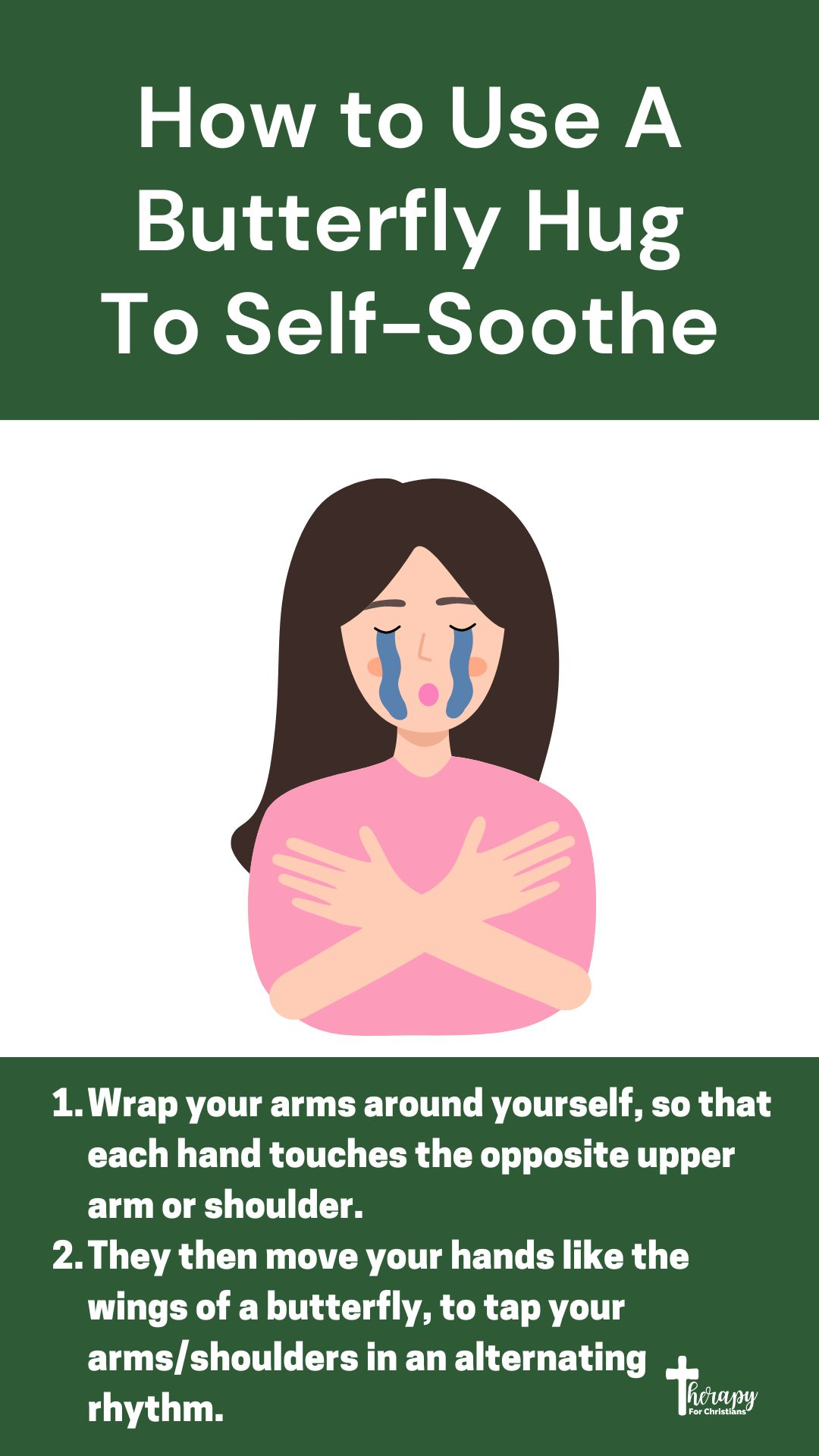

We all experience stress and anxiety, from work pressure to family drama. Many of us use coping strategies such as deep breathing, mindfulness techniques, or other relaxation exercises to help ease the symptoms of these feelings. But sometimes, traditional methods just don't cut it. That's when we turn to alternative therapies like Eye Movement Desensitization and Reprocessing (EMDR).
EMDR therapists, somatic therapist and others have used the Butterfly Hug technique for years to help those with Post Traumatic Stress Disorder (PTSD) and other mental health issues. In this article, we'll discuss what a butterfly hug is, how it works, and why it can be so helpful in transforming the way we view and cope with stress.

History of The Butterfly Hug Technique
The "Butterfly Hug," also known as the "Hug of Self-Love," was first introduced by Lucy Artigas during her work in Acapulco with survivors of Hurricane Paulina back in 1997. Later, in the early 2000s, therapists, notably those practicing EMDR therapy, adopted this method to assist individuals dealing with trauma symptoms.
The butterfly hug is believed to be based on an ancient Tibetan tradition called "Calming Touch," designed to help individuals relax and connect with their inner being. This technique has also been linked to Native American healing practices such as smudging, where a person takes handfuls of herbs and waves them in front of their body to create scented smoke for healing purposes.
How Does the Butterfly Hug Connect To The Brain?
The butterfly hug is a simple technique that therapist use to help their clients relax and become less emotionally activated. It's based on the idea that by touching your fingertips together in front of your chest while taking deep breaths, the brain will be stimulated into a 'rest-and-digest' mode instead of 'fight or flight' (which is associated with anxiety, fear, anger, and other potentially negative emotional reactions).
The butterfly hug encourages the body to relax, stimulating the parasympathetic nervous system. This helps reduce stress levels and allows individuals to remain calm and focused during therapy sessions.
Why Does This Technique Help PTSD Symptoms?
The origin of the Butterfly Hug technique is unclear, but it was likely developed to help people with PTSD who struggle with flashbacks or have difficulty regulating their emotions. By creating a calming environment and providing the client with physical contact, the Butterfly Hug sends the message that they are safe and in control of their body. This allows them to be more open to processing traumatic experiences while also allowing for improved communication between the client and therapist. Furthermore, this technique has also been found to reduce symptoms of anxiety, depression, stress, and even insomnia when used as part of an overall EMDR treatment plan.
The butterfly hug is a self-soothing technique that can help manage strong emotions, including those associated with PTSD. Here's how to do it:
- Cross your arms over your chest: Imagine giving yourself a hug. Place the middle finger of each hand just below your collarbone on opposite sides.
- Hand position: Relax your hands with fingers spread out, resting on your chest. Your thumbs should be pointing towards your chin. You can interlock your thumbs to create a butterfly body shape, or leave them separate for comfort.
- Flutter the wings: Gently and rhythmically pat your hands on your chest in an alternating motion, like a butterfly flapping its wings. Left, right, left, right... Maintain a slow and steady pace.
- Breathing: Focus on deep, slow breaths while fluttering your "wings." Breathe in through your nose and out through your mouth.
Additional Tips:
- Close your eyes or soften your gaze if that feels calming.
- Focus on the sensations of touch and the rhythm of your breath.
- If strong emotions arise, acknowledge them without judgment and continue the butterfly hug.
- There's no set time, but aim for at least 30 seconds of continuous fluttering and deep breaths.
Alternative method: If crossing your arms feels uncomfortable, you can simply place one hand on your opposite upper arm and the other hand on your other upper arm (like the picture below). Then, gently tap your upper arms in an alternating rhythm.
 Important Note: The butterfly hug is a helpful tool, but it's not a replacement for professional help. If you're struggling with PTSD or strong emotions, consider seeking therapy from a licensed mental health professional.
Important Note: The butterfly hug is a helpful tool, but it's not a replacement for professional help. If you're struggling with PTSD or strong emotions, consider seeking therapy from a licensed mental health professional.
What are the benefits of doing a butterfly hug?
Here are some potential benefits of the butterfly hug:
Self-soothing: The repetitive motion of crossing and tapping the arms can help to calm the nervous system and reduce feelings of distress or anxiety.
Bilateral Stimulation: The alternating tapping on the left and right sides of the body can stimulate both hemispheres of the brain, which may aid in processing distressing memories or emotions.
Grounding: The physical sensation of the tapping can help individuals to stay present and connected to their bodies, which can be especially helpful during moments of dissociation or flashbacks.
Regulation of Emotions: The rhythmic movement of the butterfly hug can help to regulate emotions, making it a useful tool for managing intense feelings such as anger or sadness.
Accessible: The butterfly hug can be easily performed anywhere and at any time, making it a convenient self-soothing technique for individuals to use whenever they are feeling overwhelmed.
Empowerment: Engaging in the butterfly hug can give individuals a sense of control over their emotions and reactions, empowering them to cope with difficult situations more effectively.
Overall, while the butterfly hug may seem simple, its benefits can be profound for individuals who are seeking to regulate their emotions and manage distress.
When Can I Use The Butterfly Hug Technique?
The Butterfly Hug can be used anytime you need to calm your mind or body down. It's especially useful for those who experience anxiety, panic attacks, or PTSD symptoms. Some people find it helpful to use the Butterfly Hug in the morning to set the tone for the day ahead, while others like to do it before bedtime to help them relax and sleep better.
Can I Only Use The Butterfly Hug Technique As Part Of EMDR?
No! The Butterfly Hug is an excellent technique even if you don't practice EMDR therapy. You can use this exercise anytime to reduce stress and create a sense of calmness in your body. This technique can be used independently or as part of a larger self-care routine that includes yoga, meditation, breathing exercises, and other relaxation techniques.
 Pin It & Save for Later
Pin It & Save for Later
Alternative Techniques to The Butterfly Hug
The Butterfly hug is just one one many techniques that have shown the healing power of touch. Other techniques can help you manage anxiety and stress, such as progressive muscle relaxation, guided imagery, or mindfulness. All of these approaches have the potential to help reduce symptoms of distress and increase feelings of calmness. However, if you're looking for something different or more hands-on, why not try the Butterfly Hug? It's a powerful way to ease anxiety and reconnect with your inner self.

Final Thoughts on Butterfly Hugs
the Butterfly Hug technique offers a simple yet profound method for managing stress and anxiety. By engaging the body's natural relaxation response, it helps individuals find calmness amidst turmoil. Whether used independently or as part of therapy, this technique exemplifies the healing power of touch, providing a pathway to inner peace and transformation. Remember, it's just one technique among many, and if you're struggling, consider seeking professional help.
Before you leave, we would appreciate it if you helped us spread the word by sharing, tweeting, pinning, etc. this post.
About the Author:
Corine Williams, Ph.D. is Clinical Psychologist that is currently seeing clients in the States of Maryland, New Jersey, and New York. You can find out more about her practice by visiting www.therapyforchristians.com/corinewilliams. In addition to providing individual therapy, Dr. Williams is also passionate about writing books and designing merchandise that educate, uplift, and normalize mental health subject in the Christian community. You can find out more about her at www.booksbycorine.com or by visiting her amazon profile here: https://www.amazon.com/Corine-Hyman/e/B00AWZ5FL2
Help us increase mental health awareness in the Christian community by donating through our paypal link here: www.paypal.com/therapyforchristians, joining our mailing list by clicking below, or join our provider list here: Provider listing
Disclaimer: the information, including but not limited to, text, graphics, images and other material contained on this article are for informational purposes only. No material on this site is intended to be a substitute for professional medical advice, diagnosis or treatment. If you are looking for a Christian counselor near you, please check out our directory located here: Christians Therapist Near Me
Featured Christian Therapists
Specialty Psychiatrist or Nurse Practiti... Located in Shelburne, VT
View ListingSpecialty Psychiatrist or Nurse Practiti... Located in Richmond Heights, MO
View Listing.png)
)-(3).jpg)












